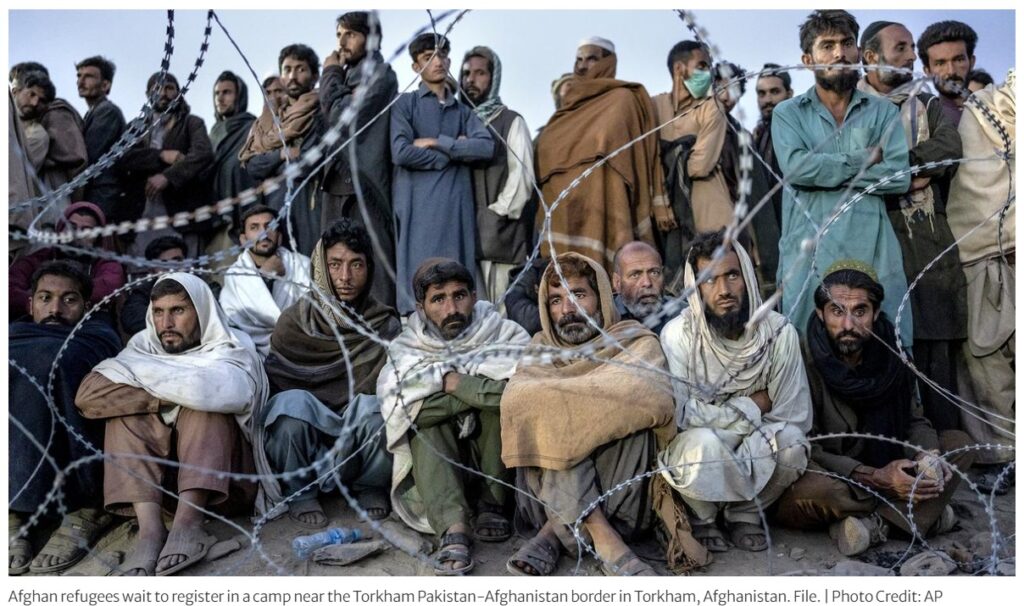On the morning of April 15th, 2025, Pakistani police raided the homes of refugees and transported some to a camp Police in the E11/2 area of Islamabad. The raids were conducted without prior notice and took several people into custody, including women and children. Those detained were reportedly transferred to Haji Camp, a holding facility used for migrant processing. Most of the detainees were people waiting for their immigration cases to be processed by third countries. These include journalists and prosecutors of the previous government who fled to Pakistan for fear of Taliban retaliation, and their deportation “increases their risk of assassination, arrest and torture by the Taliban.” Earlier, relatives of Afghan journalist Fereshteh Sadeed had told the media that police had arrested Sadeed and transferred her to the Haji camp.
In recent days, the Pakistani government has intensified its efforts to detain and deport Afghan refugees across various regions of the country, following the expiration of the processing deadline. The current deportation of Afghan refugees by Pakistan represents one of the most significant forced displacement crises in recent history, resulting from years of migration and escalating security issues.
Deportation process
In October 2023, Pakistan announced plans to deport undocumented foreign nationals, mainly targeting illegal Afghan immigrants. Officials estimated around 1.73 million Afghans were living in Pakistan. From October to January, over 813,300 individuals were sent back to Afghanistan. The deportation process is being conducted in phases, starting with undocumented migrants and set to finish by January 2024. The third phase now focuses on refugees registered with the UNHCR. The effort includes forced removals and police operations, with nearly 60,000 people crossing through the Torkham and Spin Boldak border into Afghanistan between April 1 and April 13. Additionally, Pakistan seized about US$4 billion in Afghan assets.
Key trigger for the current deportations
Pakistan’s choice to repatriate Afghan refugees is largely influenced by security issues in the border regions along the Durand Line with Afghanistan. This area has seen the activities of Tehrik-i-Taliban Pakistan (TTP) and other factions that have launched attacks on Pakistani territory and engaged in cross-border smuggling of illegal arms, ammunition, and narcotics.
Initial hopes among Pakistani security officials following the Taliban’s takeover in Afghanistan quickly diminished when the Taliban released numerous detained TTP fighters, including senior leaders. This action marked the beginning of a decline in relations between Pakistan and the Taliban, coinciding with an increase in terrorist activities within Pakistan.
In 2023, the same year the deportation order was announced, there were reportedly 24 suicide bombings attributed to Afghan nationals. “A significant portion of those involved in criminal and terrorist activities are among these illegal immigrants,” stated Pakistan’s then-interim Prime Minister Anwaar-ul-Haq Kakar in November 2023.
Afghan factions, particularly the Tehrik-i-Taliban Pakistan (TTP), are supporting Balochi insurgents in Pakistan, exacerbating security issues. The Pakistan Army faces pressure to address Balochistan’s slipping control. Balochistan Liberation Army (BLA) has improved operational capabilities due to alliances with TTP and access to advanced American weaponry. BLA leaders often find sanctuary in Afghanistan. In 2024, BLA was the most active militant group in Pakistan, carrying out 302 attacks.
Pakistan is dealing with conflicts on its northern and southwestern borders, reportedly supported by Afghan extremist groups. This is not the first time Pakistan has used security concerns to justify actions against migration, as seen in 2016 when it deported around six hundred thousand Afghan migrants. Now, Pakistan is pushing the Taliban to combat militant groups near this border. Shortly thereafter, Pakistan commenced the construction of a fence along the Durand Line.
The current deportation efforts seem aimed at pressuring the Taliban to act against militant groups near this disputed border. The Pakistan Army is seeking enhanced cooperation from Kabul on counterterrorism, using the refugee situation to further this objective.
Additional motivations behind Pakistan’s move
Many view Pakistan’s deportation strategy as a form of economic scapegoating directed at Afghan refugees, attributing various issues such as crime, unemployment, and social unrest to them. Additional reports suggest that the government, acting opportunistically, seeks to appease its populace by targeting perceived ‘foreign burdens’ as a means to divert attention from its own shortcomings. Furthermore, demographic manipulation is purportedly another objective of the Pakistani government, particularly focused on diminishing the Pashtun population in areas adjacent to the Durand Line.
Repercussions for Afghan-Pak relations
Considering the historical connections between the Taliban and Pakistan, the Taliban might interpret this policy as a betrayal, which could exacerbate tensions in their relationship. The enforced repatriation may be seen as a neglect of Afghanistan’s humanitarian crisis, thereby hindering the Taliban’s attempts to achieve stability within the nation. Additionally, the deportations have created new challenges for cross-border trade, impacting economic relations and the flow of goods between Pakistan and Afghanistan. This situation could lead to wider implications for regional trade and economic integration.
Conclusion
Driven by security concerns, populist sentiments, and economic difficulties, the repatriation of Afghan refugees from Pakistan highlights the country’s struggle to balance internal stability with its diplomatic and humanitarian obligations. Returning refugees to an unstable Afghanistan, led by an unrecognized authority, underscores the need for a cooperative regional approach. This requires active involvement from the governments of Pakistan and Afghanistan, along with the international community, to foster meaningful dialogue and establish protective measures for refugees.

